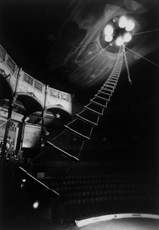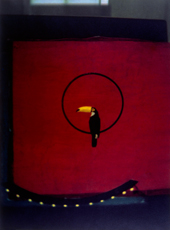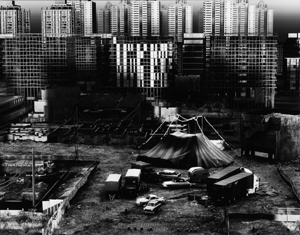*Le cirque en majeste*: a majestic photograph exhibition on circus
IMAGINE YOURSELF going up the ladder of the circus on the right. With nobody else but yourself, you
 | ||
| Rene-Jacques, <Sans Titre>, 30.5*24.2cm, ©Bruno Scotto, Paris |
Flavored with assorted views of photographers around the globe, the exhibition gives viewers an insight into the world of Circus. The special theme exhibition Le cirque en majeste of the Daelim Contemporary Art Museum is scheduled to be held until the end of October. It displays roughly 90 works of 17 celebrated photographers with various ethnic backgrounds and demonstrates as much unique styles of each photographer. Owned by the FNAC (Fonds National d'Art Contemporain)?National Fund of Contemporary Art in France?the photographs exhibit a variety of aspects about the theme of circus. The exhibition displays the unique colors of each circus performer and their feats, unveils the realities hidden behind the shows, and then, ultimately conveys the photographers’ messages. Most of all, the combination of circus and photography itself provides exceptional appeal to this exhibition. Along with the photographers’ unique interpretation on performers, various techniques such as composites, blurs and others add onto their own authentic styles.
Circus and photography
The harmony of the two fascinating realms of circus and photography ooze forth an irresistible charm to the viewers. Circus also has long been a beloved theme in the field of art, for it has been the source of the artists’ inspirations. “The circus is a recognized theme among popular artists in Europe. Many works from great masters such as Picasso, Chagall, and Degas evince the fact,'' says Ji Sang-hyun, the curator of the exhibition. With similar inspiration as that of the painters, the 17 photographers reflect their own individuality on their photographs. Moreover, the circus tent provided them an excellent place for experimentation due to the distinctions made through contrasts between lightness and darkness. “Under the dark circus tent, the photographers had the opportunity to test the maximum capacity of the camera as well as to challenge their techniques,” comments Ji. In addition to the contrast, the nimble performances could offer the photographers an adequate challenge.
Sublimation of an instant as an art
A place full of activity and entertainment, the circus grants photographers the task to grasp the fleeting movements and sublimate them as preservable art. Moreover, through their keen observations, the photographers snatch the scenes at just the right moment, making photography function as a record. Owing to their special capability as artists, however, the photographs in this exhibition do not act as mere records of the past. For example, in the first exhibit hall on the second floor, works of a renowned American photographer Rhona Bitner, demonstrate vivid portrayals and dazzling colors of the performers. A case in point is *Circus A4* from her series of contemporary color vignettes of circus clowns and acrobats isolated in the spotlight. The *Circus A4* portrays seven little circus performers marching together under a spotlight. Isolating the characters from the black background, Bitner’s own style is also apparent in the photograph. Since the characters are vibrant and glowing in contrast with the darkness, a fairytale-like ambience can be created, reminding the audience of the seven dwarfs from *Snow White*. Likewise, a circus performance, when filtered through the eyes of a photographer, could possibly arouse fantasy in the audiences’ minds.
Ambivalence along with fantasy
 | ||
| Sarah Moon, <Le Toucan>, 1998, 75.4*56.2cm, ©Bruno Scotto, Paris. |
Beyond the captured fantasies, the seizing of the surrounding impression by Sarah Moon insinuates the underlying ambivalence. Previously a fashion model, the illustrious French photographer Sarah Moon successfully creates a poetic atmosphere by capturing each object’s exclusive auras. Located in another hall of second floor, Moon’s works also bring forth a fairytale-like ambience just as those of Rhona Bitner; however, a significant difference lies in the fact that Moon focuses on the darker side. In *Cirque Drurova 2*, she portrays a black-and-white scene where a circus performer exits the stage with an animal, while vanishing into the darkness. One may wonder: why is it the depiction of the performer exiting, instead of a sparkling performance? The reason could be found in the underlain history. The Circus Drurova, which had been supported by the Soviet Union, had to suffer gravely from economic deficiencies due to the collapse of its patron. Through the gritty metaphor, Moon intended to convey the impoverished situation of the circus on the verge of maintenance.
Furthermore, animals in her work play an effective role in revealing the realities behind the scenes. The pelican of *La Pelican*, for instance, seems like a simple image of an animal; yet, the truth is more than that. The pelican is said to have died of starvation on the day the photograph was taken. Shockingly, it represents the animals that are being sacrificed by human beings. At the first glance, however, one may not be able to grasp the main point the photographer tried to express. Still, that is the fascinating aspect of Sarah Moon’s works. In order to appreciate the photographs, genuine observation and interest are critical. Getting to know the circus and photography both require similar process of knowing a person. Without such a sincere attitude, their worth could be overlooked. Likewise, the photographs enable a person’s limited horizon to widen.
The naked truth
 | ||
| Ryuta Amae, <Architectonic>, 2002, 110*113cm, ©Cnap/Y.Chenot, Paris |
While Sarah Moon implies the truth through the portrayal of the ambience, reality of the circus is divulged more explicitly in the works of French photographer Alain Fleischer. His nostalgic portrayal on the disappearing features of circus emerges as a rather striking revelation to viewers. The photographs depict extraordinary poses of a female nude contortionist that barely anyone could possibly imitate. Indeed, many people may not have even known the existence of such contortion. How painful would that training have been? Yet, the professional does not show any sign of pain. Rather, she portrays confidence. This form of contortion is now actually being banned in France due to its burden on human body and its possible injury. Once informed of the fact, the photographs appear differently. In truth, the contortionist may be performing her last contortion to let it permanently live in the photographs.
Rarely spotted in the current society, the circus is alive inside the photographs. With variety of photographs each conveying different messages, the exhibition enables the viewers to realize the multifold facets of the circus. Along with their own exotic and authentic aspects, the photographs let the audience know better about the circus. Moreover, it conveys the trite yet exceedingly clear message: appearance is not everything.

